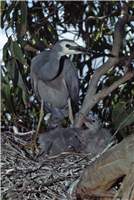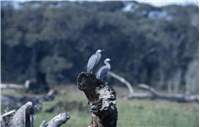Family
Ardeidae
Genus
Egretta
Species
novaehollandiae
Threats/Control Methods - Regional
In times of prolonged drought, species numbers decline, as they will only breed when the water levels around a waterbody exceed a certain level. They are threatened by the diversion of water away from naturally flowing rivers and wetlands into irrigation and human use.
Threats/Control Methods - Local
Water bodies in urban areas are less resilient against periods of droughts or extreme weather events, causing a build-up of toxins and dangerous algae levels, which may impact the health of this species. This species relies on a range of healthy water species for feeding and is therefore impacted if water sources become polluted.
Local/Urban Actions
Joining in with a local Waterwatch activity can help improve the water quality of Canberra's waterways and therefore improve important habitat areas for this species. At home, it is important avoid chemicals, pet faeces or garden waste going down the stormwater drain. Keep gutters clean and call the Canberra Connect helpline (02) 6207 9777 for specific chemical waste disposal information.
Common Names
White-faced Heron, Blue Crane, Matuka, White-fronted Heron
Distinguishing Features
A fairly small heron at 66-69cm in size, this species isblue-grey in colour, with long legs, a long neck and a long bill. Its face is white, its bill grey and its legs are yellow. During the breeding season, pale brown feathers appear at the base of the neck and on the back. Young birds lack the white face and brown feathers.
Survey Techniques
Call and visual identification.
Species Call
A croaking 'graaw' or grunting 'urgk-urg-urgh', or a high-pitched 'wrank' alarm.
Similar Species
The White-necked Heron (Ardea pacifica) is larger, with darker plumage and a white face, neck and underbody.
Distribution
This species is found right across Australia and surrounding islands, including Indonesia, Papua New Guinea and New Caledonia.
Country of Origin
Australia
Conservation (Pet/Pest) Status - Regional
The population numbers have fluctuated but appear to be rising (COG).
Conservation (Pet/Pest) Status - National
Secure, not listed under the EPBC Act 1999. This is probably the most common and best-known heron in Australia.
LSCCES Population
Four seasonal sightings were made at Civic West on the edge of Lake Burley Griffin. The species is also known to occur along Sullivans Creek on the ANU campus.
Associated vegetation community
This species is usually found in shallow wetlands or swamps, dams and lakes. They will also inhabit salty water estuaries, mangroves and beaches. Their numbers have increased due to the favourable conditions produced from open pastures, irrigation and farm dams.
Limiting Resources
A good source of water is essential for breeding and the best seasons only come after a flooding rainfall event, as they will only breed when water levels around wetlands are extremely high. Tall trees for nesting in are also necessary.
Breeding
The White-faced Heron breeds from September to December and both parents share nesting tasks. Breeding pairs choose a fork of braches high in a tall tree, up to 3 km from a good waterbody. Their nest is a flimsy compilation of sticks, about 40cm in diameter. Usually 3-4 light blue-green eggs are laid and incubated for about 24 days, with young flying from the nest after 40-45 days. In areas of flood and abundant food, nesting may become colonial, as all birds cram together to share nesting resources.
Behaviour
They are fairly vocal birds, calling at their nest, when landing at their roost, while courting, contacting others or in alarm. Birds usually fly singularly, with their heads tucked in and with steady wing-beats. When food and water is abundant the birds will merge in large colonies. When feeding, they walk through the shallows, patiently waiting to dart forwards to spear its prey. They can be seen perched on fences, dead trees and telephone posts.
Functional Group
Food Species
The diet of the White-faced Heron is extremely varied, as they will eat almost any small amimal, especially small fish, amphibians and aquatic insects.
Predators
The eggs and young birds of this species may be vulnerable to attack from Black Rats (Rattus Rattus) and Swamp Harriers (Circus aeruginosus).
Interesting Fact
This Heron can dart forward to fish at a tremendous pace, catching a fish in an instant. This movement is due to a special hinge mechanism in one of their neck vertebra.
References - (reader suitability of references, P=Primary teachers, S=Secondary students, T=Tertiary students and researchers)
Books:Morcombe, M. 2000. Field Guide to Australian Birds. Steve Parish Publishing. Archerfield. Australia P, S, T
Pringle, J. 1985. The Waterbirds of Australia. Angus and Robertson/National Photographic Index of Australian Wildlife. Sydney. P, S, T
Veerman, P. 2003. Canberra Birds: A report on the first 21 years of the garden bird survey. Philip Veerman and Canberra Ornithologists Group. Canberra. S, T
Internet: Canberra Ornithological Group (COG). 2004. Birds of Canberra Gardens. COG and the ACT Department of Urban Services. [online]. Available at:http://garden.canberrabirds.org.au/ P, S, T
Online Publications:ACT Government. 2006. Information Sheet: Stormwater Pollution from Residential Areas. Environment ACT. [online]. Available at: http://www.environment.act.gov.au/__data/assets/pdf_file/13168/Stormwater_Pollution_from_Residential_Areas.pdf P, S, T
Nix, H. and Cunningham, R. 2006. Birds of the Lower Sullivans Creek Catchment, Canberra ACT. Prepared for the Life in the Suburbs project using data from the Lower Sullivans Creek Catchment Ecological Survey (LSCCES). Australian National University. Canberra. [online]. Available at: http://www.lifeinthesuburbs.com.au/category.php?id=65 S, T
Olsen, P. and Weston, M. 2004. The State of Australian Birds 2004: Water Wetlands and Birds. Birds Australia. [online] Available at: http://www.environment.gov.au/biodiversity/publications/birds-04/regional.html S, T


 Top
Top Top
Top